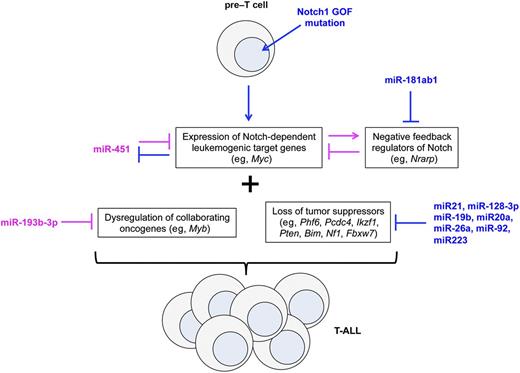In this issue of Blood, Junker et al delineate a novel signaling axis involving miR-21 and the tumor suppressor Pdcd4 that is essential for Notch-mediated induction of T-cell acute lymphoblastic leukemia (T-ALL).1
Schematic representation of miRNAs that target tumor suppressors (onco-miRNAs, blue) or oncogenes (tumor-suppressive miRNAs, magenta) in Notch-induced T-ALL. Events that promote leukemogenesis are highlighted in blue, whereas those that suppress leukemogenesis are shown in magenta. GOF, gain of function.
Schematic representation of miRNAs that target tumor suppressors (onco-miRNAs, blue) or oncogenes (tumor-suppressive miRNAs, magenta) in Notch-induced T-ALL. Events that promote leukemogenesis are highlighted in blue, whereas those that suppress leukemogenesis are shown in magenta. GOF, gain of function.
Mutations that activate Notch signaling are among the most frequent oncogenic events in human T-ALL and murine models of this disease.2 Following activation by successive proteolytic cleavages carried out by ADAM metalloproteases and the γ-secretase complex, Notch acts by forming a transcriptional activation complex on genomic response elements. When Notch activation is excessive and sustained, Notch complexes drive a leukemogenic program of gene expression in T-cell progenitors. The transforming effects of Notch are highly context dependent, and indeed in other cell types such as squamous cells, Notch has important tumor-suppressive activities.3 These sorts of observations have led to interest in defining not only the direct Notch target genes that contribute to leukemogenesis but also other essential elements of the pre–T-cell context that collaborate to create a cell state that is susceptible to Notch-mediated transformation, in hopes of identifying vulnerabilities that might be exploited to target T-ALL cells.
It is increasing evident that alterations in the expression of not only protein-encoding genes but also regulatory RNAs, such as microRNAs (miRNAs), contribute to cellular transformation and the acquisition of cancer hallmarks, the key properties that define malignant cells. To shed light on the role of miRNAs in Notch-induced T-ALL, Junker et al first studied the effect of conditional knockout of Dicer1, an essential component of the miRNA processing machinery, in T-cell progenitors. They observed that biallelic (but not monoallelic) loss of Dicer1 function interfered with T-ALL development and also led to the regression of established Notch-induced T-ALLs. By contrast, loss of Dicer1 is permissive for T-cell development, albeit with some abnormalities, indicating that the Notch-on transformed state is marked by an increased dependency on one or more miRNAs.
Next, Junker et al showed in studies with cultured T-ALL cells that acute deletion of Dicer1 increased apoptosis, pointing to a role for one or more miRNAs in the survival of T-ALL cells. To identify onco-miRNA(s) that contribute to this dependency, Junker et al turned to miRNA expression profiles obtained from normal pre–T-cells at various stages of development and from Notch-addicted human T-ALL cell lines, reasoning that miRNAs that are highly expressed in normal pre–T-cells at stages where Notch is active and in Notch-transformed pre–T-cells are likely candidates to mediate the observed phenotype. One miRNA with the expected expression pattern is miR-21, and using specific nucleic acid antagonists of miR-21, they were successful in demonstrating that loss of miR-21 led to the apoptosis of Notch-addicted murine and human T-ALL cell lines.
Junker et al then went back to public databases and informatics approaches to try to identify conserved miR-21 targets in pre–T-cell and T-ALL cells that might have proapoptotic effects. This led to the identification of Pdcd4 (programmed cell death 4), a gene previously implicated in a miR-21–mediated signaling axis that governs cell death in a number of cancers, such as colorectal carcinoma.4 As predicted, misexpression of Pdcd4 induced the apoptosis of T-ALL cells, and knockdown of Pdcd4 rescued T-ALL cells from the effects of loss of miR-21 function. Although the function of Pdcd4 remains uncertain, it has been implicated in regulation of Bcl-XL5 ; in line with this idea, Junker et al also showed that Bcl-XL expression was decreased in T-ALL cells by loss of miR-21 and rescued in cells in which both miR-21 and Pcdc4 were targeted.
The contribution of miR-21 to Notch-induced T-ALL documented by Junker et al adds to an increasingly complex web of interactions involving Notch signaling and noncoding RNAs that contribute to the pathogenesis of this aggressive hematologic malignancy (see figure). In addition to miR-21, other implicated miRNAs include mir-181ab1, which appears to dampen the expression of negative regulators of Notch such as Nrarp, thereby helping Notch clear the signaling threshold that is required for leukemogenesis; miR-451, a Dicer1-independent miRNA that is repressed by Notch, an alteration that contributes to Notch’s ability to upregulate and sustain Myc expression6 ; miR-193b-3p, which suppresses Notch-induced T-ALL development by repressing Myb,7 a “pioneer” transcription factor that dysregulates other oncogenes that contribute to T-ALL development; and numerous other “onco-miRNAs” targeting a who’s who of tumor suppressors in T-ALL, including Ikzf1, Pten, Phf6, Bim, Nf1, and Fbxw7,8 in addition to the aforementioned Pcdc4.1 This panoply of miRNAs may prove to be the tip of the proverbial noncoding RNA iceberg, as other recent papers have implicated long intervening noncoding RNAs, including some that are directly regulated by Notch,9,10 as participants in T-ALL pathogenesis.
The challenge now is to translate these insights into new approaches that inform the diagnosis and improve the treatment of T-ALL and other blood cancers. An increasing number of diagnostic tests are coming on line that are centered on detection of specific miRNAs in situ, in tumor cell lysates, and free in blood. Therapeutic miRNA targeting strategies also are in various stages of development, including agents that specifically target miR-21 or that are preferentially active in the tumor microenvironment. Much additional work is needed to determine if these (or any of the many other leads being pursued) can be brought to fruition, to the benefit of patients with T-ALL and other blood cancers.
Conflict-of-interest disclosure: The author declares no competing financial interests.



